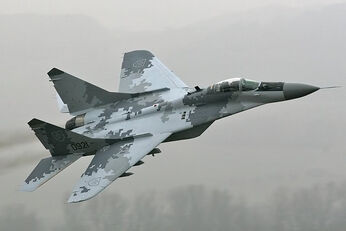
The Mikoyan MiG-29 (Russian: Микоян и Гуревич МиГ-29; NATO reporting name: "Fulcrum") is a fourth-generation jet fighter aircraft designed in the Soviet Union for an air superiority role. Developed in the 1970s by the Mikoyan design bureau, it entered service with the Soviet Air Force in 1983, and remains in use by the Russian Air Force as well as in many other nations. The NATO name "Fulcrum" was sometimes unofficially used by Soviet pilots in service.[6]
The MiG-29, along with the Sukhoi Su-27, was developed to counter new American fighters such as the McDonnell Douglas F-15 Eagle, and the General Dynamics F-16 Fighting Falcon.[7]
Development[]
edit Origins[]
In 1969 the existence of the United States Air Force's "F-X" program, which would result in the McDonnell Douglas F-15 Eagle, became public knowledge.[8]At the height of the Cold War, a Soviet response was necessary to avoid the possibility of a new American fighter gaining a serious technological advantage over existing Soviet fighters, thus the development of a new air superiority fighter became a priority.[7] The Soviet General Staff issued a requirement for a Perspektivnyy Frontovoy Istrebitel (PFI, translating directly as "Perspective Frontline Fighter", roughly "Advanced Frontline Fighter").[9] Specifications were extremely ambitious, calling for long range, good short-field performance (including the ability to use austere runways), excellent agility, Mach 2+ speed, and heavy armament. The Russian aerodynamics institute TsAGI worked in collaboration with the Sukhoi design bureau on the aircraft's aerodynamics.[9]
However, in 1971 Soviet studies determined the need for different types of fighters. The PFI program was supplemented with the LPFI (Perspektivnyy Lyogkiy Frontovoy Istrebitel, or "Advanced Lightweight Tactical Fighter") program; the Soviet fighter force was planned to be approximately 33% PFI and 67% LPFI.[10]PFI and LPFI paralleled the USAF's decision that created the "Lightweight Fighter" program and the General Dynamics F-16 Fighting Falcon and Northrop YF-17.[11] The PFI fighter was assigned to Sukhoi, resulting in the Sukhoi Su-27, while the lightweight fighter went to Mikoyan. Detailed design work on the resultant Mikoyan Product 9, designated MiG-29A, began in 1974, with the first flight taking place on 6 October 1977. The pre-production aircraft was first spotted by United States reconnaissance satellites in November of that year; it was dubbed Ram-L because it was observed at the Zhukovsky flight test center near the town of Ramenskoye. Early Western speculations suggested that the Ram-L was very similar in appearance to the YF-17 and powered by afterburning Tumansky R-25 turbojets.
Despite program delays caused by the loss of two prototypes in engine-related accidents (third prototype on 15 June 1978 and the fifth prototype on 31 October 1980), the MiG-29B production version entered service in August 1983 at the Kubinka air base. State acceptance trials were completed in 1984, and deliveries began the same year to the Soviet Frontal Aviation.
The workload split between TPFI and LPFI became more apparent as the MiG-29 filtered into front line service with the Soviet Air Forces (Russian: Voenno-Vozdushnye Sily [VVS]) in the mid-1980s. While the heavy, long range Su-27 was tasked with the more exotic and dangerous role of deep air-to-air sweeps of NATO high-value assets, the smaller MiG-29 directly replaced the MiG-23 in the frontal aviation role. Features such as rugged landing gear and protective intake grates allowed MiG-29 operations from damaged or under-prepared airstrips that Soviet war planners expected to encounter during a rapid armored advance. The MiG-29 was to be an escort for local strike and interdiction air packages, protecting vulnerable ground attack aircraft from NATO fighters such as the F-15 and F-16. The MiG-29 was positioned relatively close to the front lines, and would have been tasked with providing local air superiority to advancing Soviet motorized army units.[citation needed]
Introduction and improvements
n the West, the new fighter was given the NATO reporting name "Fulcrum-A" because the pre-production MiG-29A, which should have logically received this designation, remained unknown in the West at that time. The Soviet Union did not assign official names to most of its aircraft, although nicknames were common. Unusually, some Soviet pilots found the MiG-29’s NATO reporting name, "Fulcrum", to be a flattering description of the aircraft’s intended purpose, and it is sometimes unofficially used in Russian service.[6]
The MiG-29B was widely exported in downgraded versions, known as MiG-29B 9-12A and MiG-29B 9-12B for Warsaw Pact and non-Warsaw Pact nations respectively, with less capable avionics and no capability for delivering nuclear weapons. Total production was about 840 aircraft.
In the 1980s, Mikoyan developed the improved MiG-29S to use longer range R-27E and R-77 air-to-air missiles. It added a dorsal 'hump' to the upper fuselage to house a jamming system and some additional fuel capacity. The weapons load was increased to 4,000 kg (8,800 lb) with airframe strengthening. These features were included in new-built fighters and upgrades to older MiG-29s.[12][13]
Refined versions of the MiG-29 with improved avionics were fielded by the Soviet Union, but Mikoyan’s multirole variants, including a carrier-based version designated MiG-29K, were never produced in large numbers. In the post-Soviet era, MiG-29 development was influenced by the Mikoyan bureau's apparent lesser political clout than rival Sukhoi. Some more advanced versions are still being pursued for export, and updates of existing Russian aircraft are likely. New fighter versions called MiG-29M/M2 and MiG-29SMT have been developed. Furthermore, development of the MiG-29K carrier version has been resumed for the Indian Navy's INS Vikramaditya, and Russian Navy's Admiral Kuznetsov class aircraft carrier .